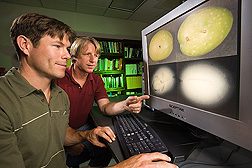This page has been archived and is being provided for reference purposes only. The page is no longer being updated, and therefore, links on the page may be invalid.
Read the magazine story to find out more. |
|
|
Olive Fruit Fly Damage Pinpointed by X-ray Vision
By Marcia WoodFebruary 26, 2009
No one loves plump, ripening olives more than the olive fruit fly. The female fly lays tiny eggs inside the fruit. The maggots that emerge from those eggs live and feed beneath the olive's skin.
When they come out of the fruit, the maggots leave a tiny exit hole in their wake. That damage, as well as the unseen havoc that they wreak inside the olive, might someday be automatically detected by a sophisticated sorting machine. That's according to agricultural engineers Ronald P. Haff and Eric S. Jackson with the Agricultural Research Service (ARS) Western Regional Research Center in Albany, Calif.
The device's X-ray technology would quickly capture images of the freshly harvested olives as they tumble along a conveyer belt. Then, a software program would enable a computer to scan the X-ray imagery and recognize internal damage. The computer would activate a sorter that would follow the computer's commands, correctly separating undamaged olives from their ruined counterparts.
All this would improve the speed, precision, and accuracy with which olive fly damage is today detected at processing plants. Right now, that chore is mainly done by hand.
In preliminary experiments, the scientists have found that the software program they're developing is able to recognize undamaged olives 90 percent of the time and severely damaged olives 86 percent of the time. The scores demonstrate that the approach is valid--and that it needs more work, according to Jackson. He expects to have the system ready for real-world testing in a processing plant within a year or so.
Jackson and Haff are likely the first to study this promising use of real-time digital X-ray imagery.
The research was funded by ARS and the grower-sponsored California Olive Committee. ARS is the principal intramural scientific research agency of the U.S. Department of Agriculture.
Read more about this and related olive fly research in the February 2009 issue of Agricultural Research magazine.

